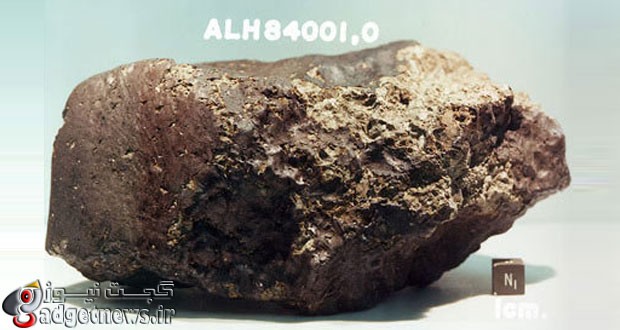تجزیه و تحلیل قدیمیترین شهابسنگ متعلق به مریخ نشان میدهد که مریخ باستانی دارای آب بوده است، اما به جای اقیانوسهای وسیع، احتمالا دریاهای کوچکی بر سطح سیاره سرخ وجود داشتند.
قدیمیترین شهابسنگ مریخی موسوم به ALH84001 حدود 13 هزار سال قبل به زمین سقوط کرد و 30 سال قبل در منطقهای در قطب جنوب کشف شد.این سنگ مریخی یک تکه از ماگمای جامد از آتشفشانی است که حدود چهار میلیارد سال قبل فوران کرده بود.
آزمایشات صورت گرفته بر روی این سنگ، وضعیت آب و هوایی سیاره سرخ را در چند میلیارد سال قبل – در زمان جریان داشتن احتمالی آب بر سطح سیاره – نشان میدهد.
دکتر «روبینا شاهین» از محققان دانشگاه کالیفرنیا در سندیگو و نویسنده ارشد این تحقیق تأکید کرد: مواد معدنی موجود در شهابسنگ، شیمی باستانی مریخ و فعل و انفعالات بین آب و جو را مشخص میکند.
مایعی که احتمالا آب بوده است، از طریق منافذ به داخل سنگ نفوذ کرده و رسوبات گلبولهای کربنات و دیگر مواد معدنی در سنگ ایجاد کردند.
جو غالب مریخ، حاوی دیاکسید کربن و درعین حال مقادیر کمی ازن است؛ درجه ایزوتوپی در کربناتها نشاندهنده میزان آب و ازن در زمان شکلگیری آنها است.
سیگنال ازن در کربناتهای داخل شهابسنگ اندازهگیری شد که نشان میدهد، مریخ در گذشته باستانی خود احتمالا دارای آب بوده است؛ اما به جای اقیانوسهای وسیع، چشمانداز مریخ اولیه (احتمالا) دارای دریاهای کوچکی بوده است.
شهابسنگ ALH84001 دارای لولههای کوچک کربنات است که به عقیده برخی دانشمندان، میتواند شواهدی بالقوهای از حیات با منشأ بیولوژیکی ارائه کند.
نتایج این تحقیق در مجله PNAS منتشر شده است.
منبع : techtimes
Martian Rock Unveils Secrets About Water On Early Mars
Martian Rock Unveils Secrets About Water On Early Mars
Thanks to NASA’s Mars Curiosity rover, we’re learning new things about the red planet nearly every day. However, we’re also learning a few new details about ancient Mars here on Earth, thanks to a meteorite from the planet discovered over 30 years ago.
This meteorite, the oldest we have from Mars, is now revealing new secrets and mysteries about Mars, including what it’s early atmosphere was like and how much water the planet contained.
Scientists from the University of California, San Diego, NASA and the Smithsonian Institution recently studied the minerals trapped within the rock and released a report giving us more insight into what Mars was like in its early years.
“Minerals within the meteorite hold a snapshot of the planet’s ancient chemistry, of interactions between water and atmosphere,” says Robina Shaheen, a project scientist at UC San Diego.
The meteorite itself isn’t much to look at, but it fell to Earth over 10,000 years ago. Called ALH84001, scientists believe that its rock is actually solid magma from a Martian volcano that erupted over four billion years ago. Most importantly, liquid, potentially in the form of water, flowed into the rock at some point and deposited minerals within it, including carbonates.
Carbonates are important because they’re considered the basic building blocks of life.
So how did scientists measure the minerals inside the rock? They looked for anomalies in the isotopes. Although Mars’ atmosphere is mostly carbon dioxide, it also contains ozone. This ozone reacts with carbon dioxide in the atmosphere, creating an anomalous new molecule. This anomaly gets preserved in rock and gives scientists a way to determine how much water and ozone was present in the Martian atmosphere at the time.
Basically, deep inside the meteorite is the history of Mars’ atmosphere and surface conditions. Scientists detected ozone within the meteorite’s carbonates, which suggests what we’ve already come to suspect: Mars once had water. However, scientists believe that unlike Earth, which has oceans, Mars’ surface had smaller bodies of water, such as seas and lakes.
Scientists also discovered that the meteorite was lacking in carbon-13 and oxygen-18, suggesting that Mars once had a richer atmosphere than it does today. NASA’s MAVEN recently uncovered new details about how the planet lost its atmosphere, so this is just yet another piece in the Martian puzzle.
But what about life? Did the meteorite uncover any secrets about previous life on Mars? Although carbonates sometimes suggest microbial life, that isn’t the case here.
“The carbonate we see is not from living things,” Shaheen said. “It has anomalous oxygen isotopes that tell us this carbonate is abiotic.”
Of course, this new information also raises new questions. When did Mars, and Earth, get water? And where did Mars’ water go?
 گجت نیوز آخرین اخبار تکنولوژی، علم و خودرو
گجت نیوز آخرین اخبار تکنولوژی، علم و خودرو 






